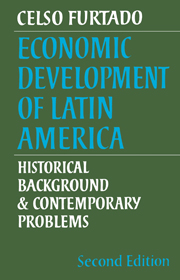Book contents
- Frontmatter
- Contents
- Tables
- Preface to the second edition
- Preface to the first edition
- Abbreviations
- Maps
- PART ONE FROM THE CONQUEST TO THE FORMATION OF NATION-STATES
- PART TWO ENTRY INTO THE SYSTEM OF INTERNATIONAL DIVISION OF LABOUR
- PART THREE THE TRADITIONAL STRUCTURAL PATTERN
- 7 Characteristics of agrarian structures
- 8 Distribution and utilisation of the social income
- 9 Monetary and foreign exchange systems
- PART FOUR CHARACTERISTICS OF THE INDUSTRIALISATION PROCESS
- PART FIVE REORIENTATION OF DEVELOPMENT IN THE RECENT PERIOD
- PART SIX INTERNATIONAL RELATIONS
- PART SEVEN INTRA-REGIONAL RELATIONS
- PART EIGHT STRUCTURAL RECONSTRUCTION POLICIES
- Bibliography
- Index
7 - Characteristics of agrarian structures
Published online by Cambridge University Press: 25 January 2010
- Frontmatter
- Contents
- Tables
- Preface to the second edition
- Preface to the first edition
- Abbreviations
- Maps
- PART ONE FROM THE CONQUEST TO THE FORMATION OF NATION-STATES
- PART TWO ENTRY INTO THE SYSTEM OF INTERNATIONAL DIVISION OF LABOUR
- PART THREE THE TRADITIONAL STRUCTURAL PATTERN
- 7 Characteristics of agrarian structures
- 8 Distribution and utilisation of the social income
- 9 Monetary and foreign exchange systems
- PART FOUR CHARACTERISTICS OF THE INDUSTRIALISATION PROCESS
- PART FIVE REORIENTATION OF DEVELOPMENT IN THE RECENT PERIOD
- PART SIX INTERNATIONAL RELATIONS
- PART SEVEN INTRA-REGIONAL RELATIONS
- PART EIGHT STRUCTURAL RECONSTRUCTION POLICIES
- Bibliography
- Index
Summary
Large estates and social organisation
In Latin America, agrarian structures are not only an element of the production system but also the basic feature of the entire social organisation. We have seen, in chapter 2, that both in the economies whose point of departure was export agriculture and in those initially organised around mining production, the large estate tended to become the basic element of social organisation. From the outset, the principle governing grants of land was that grantees should have the necessary means to exploit their lands in order to produce a surplus which could be converted into cash and partially transferred to the Crown. After independence, several countries sought to modify this principle by promoting colonization schemes under which lands were granted as family holdings to settler families who undertook to work the land themselves. This policy was nearly always bound up with the encouragement of European immigration and achieved some success in Southern Brazil, Argentina and Chile.
The family farm system made headway in regions which remained relatively isolated and were characterised by the prevalence of recent settlement of European origin. Thus, in the southern regions of Brazil, where there was no profitable export crop, the pioneer European ‘colonies’ were forced to turn to a subsistence economy, producing marginal surpluses for sale in the home market, particularly in the rapidly expanding coffee areas. Given the abundance of land and the farming techniques which settlers brought from Europe.
- Type
- Chapter
- Information
- Economic Development of Latin AmericaHistorical Background and Contemporary Problems, pp. 68 - 80Publisher: Cambridge University PressPrint publication year: 1977



